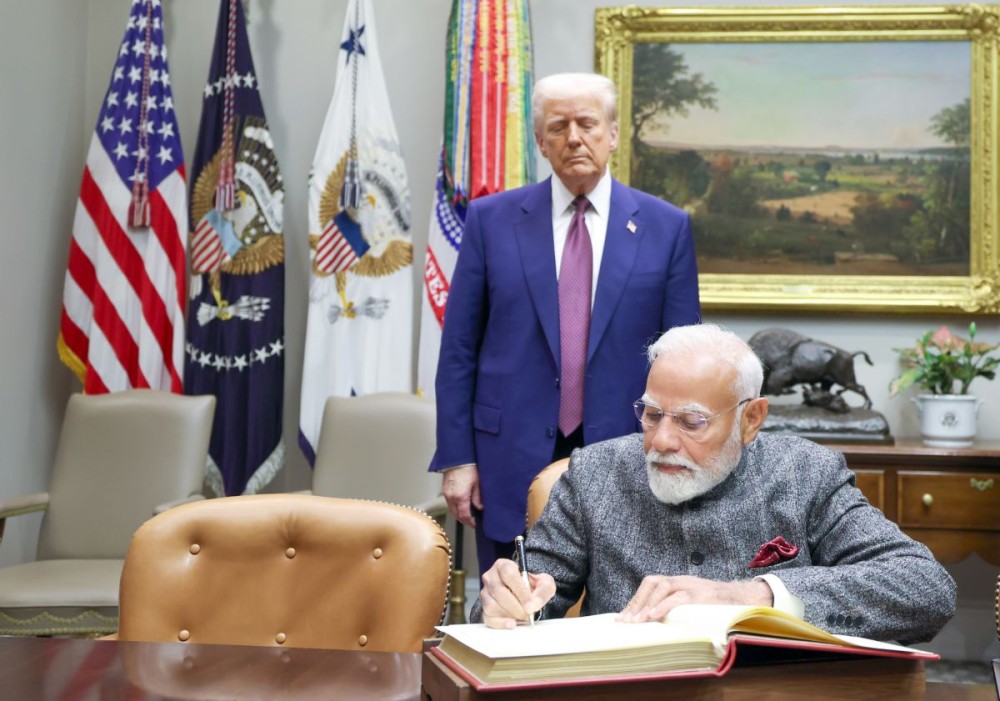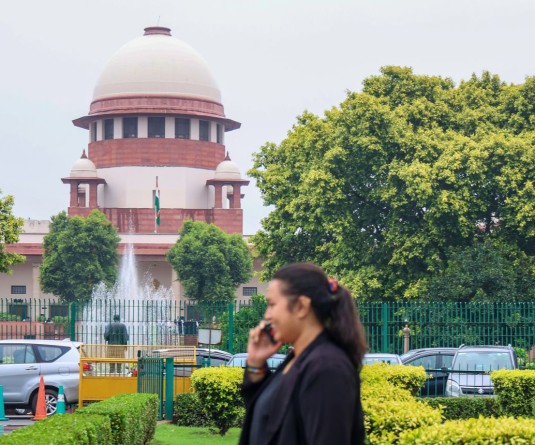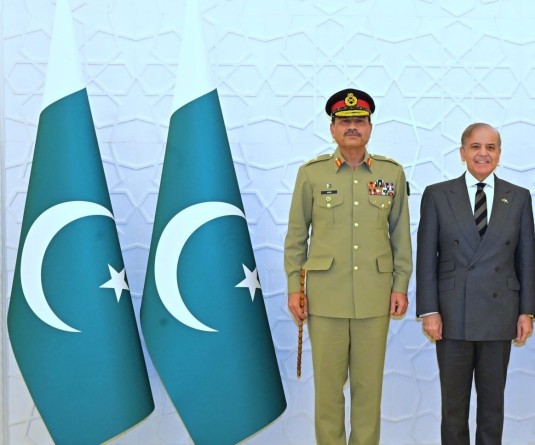Washington, DC: Prime Minister Narendra Modi signs a document in the presence of U.S. President Donald Trump in Washington, DC, on Friday, February 14, 2025. (Photo: IANS)

New Delhi, November 9 (IANS) US President Donald Trump has in his second term made it clear that the US strategy of ‘regime change’ and ‘nation building’ for imposing the American system of governance on others, was being given up- his main reservation was that astronomical amounts were being spent when ‘one size fits all’ did not seem necessary.
On a visit to Riyadh, Saudi Arabia in May 2025, Trump made a profound-sounding statement that peace, prosperity and progress came not from a rejection of heritage but from embracing your national traditions. He announced a break from the ‘interventionism’ of the prior Administration in favour of economic cooperation, regional partnerships and selective use of force. He wanted a Saudi modern rule to be achieved ‘the Arabian way’.
Trump remarked that the Middle East will be defined by ‘commerce not chaos’ and found fault with ‘failed’ intervention in Afghanistan and Iraq- in the name of ‘war on terror’. He also debunked liberal lobbies for spending trillions without achieving any thing. At the end of US President’s visit to Riyadh, Saudi Arabia announced an investment of more than 600 billion dollars in the U.S. Tulsi Gabbard Director of National Intelligence of the US, echoing the views of Donald Trump said at Bahrein’s Annual Security Conference at Manama on November 1 that past US interventions wasted tax- payers resources and ‘created more enemies than friends’.
The dramatic shift in US policy brought about by Trump consists in rejection of American interference in other nation’s internal affairs, reliance on local actors to advance stability and utilisation of business opportunities to ensure both regional and US interests.
The US President is totally focused on making US economically strong and his approach is to correct adverse balance of trade, cut down on DEI(Diversity, Equity and Inclusivity) projects and halt migrations in pursuit of ‘America First’ doctrine. It is this new policy approach of not intervening in conflicts that has enabled US to work for a ceasefire that would halt Israel-Hamas war and for a pause in the Israel’s 12 day conflict with Iran during the course of which US had bombarded Iran’s nuclear installations with bunker-buster ammunition.
Gabbard, however, did say at Manama that the Gaza ceasefire was fragile and Iran’s nuclear activity was again inviting scrutiny by the IAEA. As regards the Ukraine-Russia ‘war’, the desire of President Trump to adjust the ‘territory’ issue was not being met even after some coercion was exercised on President Zellensky, but this was not likely to cause further escalation because of a certain bonhomie that exists between Trump and Putin. Trump’s lack of enthusiasm for NATO was also making a difference.
President Trump might have realised that China was pursuing the economic route to becoming a superpower-extending its Belt & Road Initiative (BRI) as an economic instrument to influence other nations and developing technology to get the better of the world. China’s ideological and strategic bonds with Russia are unbreakable and in the China-Russia combine China could be the lead partner now. As already mentioned Trump has a degree of familiarity with President Putin of Russia and this was keeping a possible military confrontation between the two superpower camps diffused.
The one- on -one meeting between President Trump and President Xi Jinping of China in South Korea on October 30 resulted in a large economic pact setting the trend for the future. Both leaders expressed satisfaction over the outcome with Xi saying that US and China should be ‘partners and friends’. China has withdrawn controls on export of rare earth minerals to US, opened the Chinese market to Soybean and other agriculture products from US and lifted restriction against US semi-conductor manufacturers. In return, US has slashed tariff by 10 per cent on Chinese goods to bring it down to 47 per cent, while China has suspended some of its retaliatory tariffs for one year.
An economic competition between the two countries might have been perceived by them as a better option to military rivalry. As regards Russia, the treaty called START with the US was still on till next year, and Trump talking of resumption of nuclear tests if the others did not comply with it’ could just be a stand rather than a threat. However, Trump’s claim that China and Pakistan are also testing nuclear weapons would cause deep concern to India because of the history of these two neighbours acting in concert against this country.
In a geopolitical situation where US, Russia and China might have found a strategy of dealing with each other India was left with finding its own ways of handling them. With President Trump leaning towards Pakistan, the Sino-Pak strategic alliance- that for the first time saw China militarily siding with Pakistan when an armed conflict broke out between India and Pakistan following the sinister Pak-directed terrorist attack in Pahalgam on April 22, 2025- remains on top of the national security agenda of India.
India has been an active participant in BRICS as well as Quad in a bid to pursue its own national interests and even attended SCO at Tianjin in China at the summit level on August 31 to stand upfront with China- independently of Indo-US relations - to convey the impression that India was a major world power that did not seek ‘alignments’ and would judge bilateral relationships on merit. Defence Minister Rajnath Singh, speaking at the ASEAN Defence Ministers Meet in Kuala Lumpur on November 1, firmly reiterated that the vast maritime expanse of Indo-Pacific must remain ‘free of coercion’ and subject to a ‘rules-based international order’. This came at a time when China was seeking to boost its influence in the region by setting up military bases. India apparently looked upon its policy on Indo-Pacific as a check on China’s plans of extending its base to Indian Ocean.
An area of developing concern for India is the Middle East along with the Pak-Afghan belt where the appearance of Cold War on the horizon and the attempt of Pakistan to maintain a hold in Afghanistan called for India’s close attention.
The Israel-Iran hostility and the move of Shia fundamentalist Iran to take a Sunni radical force like Hamas in its embrace against Israel deepened that rift into a conflict between Islam and Zionism and the drift of China and Russia towards Iran in the face of the unstinted support of US for Israel, did revive the prospect of the return of Cold War besides making an impact on the internal security of India because of this country’s vulnerability to faith-based conflicts.
Pakistan with its background of having mediated with Taliban after the withdrawal of Soviet troops from Afghanistan to put Kabul Emirate in power in 1996 and much later having participated in Doha talks to facilitate a similar evacuation of Afghan territory by Americans leading to reinstallation of Taliban Emirate in 2021, hoped to enjoy a ‘strategic depth’ in Afghanistan against India.
The Pak-Afghanistan region could then be used for fostering cross-border terrorism against India in Kashmir and elsewhere. Incidentally, Pakistan's getting drawn towards Pentagon has created a gulf between Pakistan and the Taliban -which was extremely inimical towards the US. The attacks of Tahrir Taliban Pakistan (TTP) on Pak security establishments are to be seen in this backdrop.
India has done well to strike an equation with Taliban government in Kabul and extend full diplomatic honours to the Afghan Foreign Minister on his maiden visit to Delhi in Oct. 2025 -in the course of which he visited Darul Uloom Deoband, the Alma mater of the radical Sunni ideology. The visiting dignitary, Amir Khan Muttaqi, assured India that Afghan territory would not be allowed to be used for any anti-India activity. Following intensification of attacks by Baluch rebels on Pak army-the former represent a radical Islamic force- hostility of Pakistan towards India is on the rise and this country has to find a way of dealing with it on its own strength.
Pakistan, while being on the right side of the US, was facilitating the expansion of the China -Pakistan Economic Corridor(CPEC) on one hand and working on Bangladesh to revive strategic relationships with the latter, on the other. A combination of geopolitical circumstances are encouraging Pakistan to take on India- we have to step up watch against the hostile designs of this neighbour.






